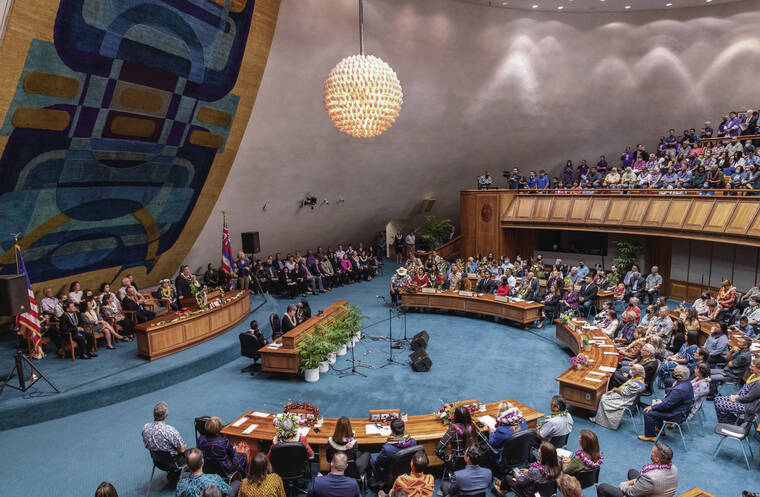The 32nd Legislature comes to
a close today — officially called “sine die” — after nearly five months of debate, testimony and haggling over legislation following a shaky start between then-new Gov. Josh Green and the state
Senate that rejected three of his Cabinet nominees, a modern-day record.
There also was plenty of legislative progress aimed at cleaning up elections and state ethics, and addressing homelessness and affordable housing, among other critical issues.
There also were moments of drama and uncertainty that will continue into today.
The state’s general fund budget of $11.3 billion in fiscal year 2024 and $10.4 billion in fiscal year 2025 won’t be voted on by both the full House and Senate until their final floor sessions today.
The Legislature, in general, supported many of Green’s initiatives, including helping teachers in the form of pay raises and future housing around their schools, and expanding his “kauhale” concept to build more tiny home villages to provide permanent housing for homeless people along with social service support.
In supporting government and political ethics reform, however, lawmakers killed proposals to impose term limits on themselves, exempted themselves from nepotism rules and failed to support public campaign financing, which advocates argued would reduce temptations for fundraising and campaign abuses.
“They folded,” said political analyst Neal Milner. “The most significant kind of corruption … is where people have access and influence. It’s a remarkably small number of people who donate to political campaigns.”
Green’s relationship with key senators got off to a bumpy start when his first Cabinet nominee
to lead the state Department of
Hawaiian Home Lands, Ikaika
Anderson, lost a vote of support following an often-bruising confirmation hearing.
When two more Cabinet nominees failed to win confirmation, Green “made remarks about the way they were treated,” Milner said. “It’s hard to know what went on after that. But to the outside view, he took his licks and moved on.”
The work to turn ideas into reality continued when about two dozen bills were quickly passed by lawmakers and became law with Green’s approval in March and April.
Yet most bills that advanced to final votes in the House and Senate, many of which are scheduled for today, are the product of lengthy debate, repeated revision and agreements often made near the last possible moment.
Of the 271 bills positioned for
final House and Senate votes this year, nearly half had final drafts agreed to by House-Senate conference committees on the last possible day, on Friday.
Legislators, at times, crammed into a single conference room speed-talking to vote on as many conference drafts as possible before a 6 p.m. deadline.
Many bills couldn’t be taken up because of time constraints or other issues and cannot become law this year.
Some of the last-minute voting can be attributed to political maneuvering, just as Congress continues to argue over raising the federal debt ceiling, said Colin Moore, who teaches public policy at the University of Hawaii and is associate professor at the University of Hawaii Economic Research Organization.
But this year’s last-minute conference committees to resolve
differences between House and Senate versions of bills was “particularly confusing,” Moore said.
”It always happens but this was a bit more than normal and a particularly confusing end of session,” he said.
Despite the rejection of three of Green’s Cabinet nominees by the Senate, Green remained positive in public statements and stayed focused over the course of the legislative session, Moore said.
“I think he did great,” Moore said. “When he was L.G. (lieutenant governor), people sometimes criticized the governor for not being a disciplined communicator. I thought he was extremely disciplined and overall did a good job of just focusing on positive developments. He didn’t get dragged into things. The messaging was pretty positive. He has some victories to point to.”
In a statement, Green said,
“In just under 5 months we are already initiating major directional changes for Hawai‘i.”
He cited “signature positive
results” including:
>> “Rebuilding our public education system with a new contact that rewards those who become teachers.”
>> More than $60 million for kauhale and Ohana Zones to address chronic homelessness.
>> $30 million in loan forgiveness to recruit and retain social workers, nurses and physicians for Hawaii.
>> Millions to refurbish and expand rural and neighbor island hospitals.
>> More than $100 million for environmental programs and climate response.
>> Tax reform to help low-
income families and partial funding for his Green Affordability Plan.
The idea of expanding so-called green fees on tourists to offset their impacts on state parks and trails and generate money to address climate change appears dead, along with expanding preschool education.
But Green said “the seeds (for both ideas) have been planted for the coming years.”
His administration also authorized $50 million worth of state grants-in-aid that had been frozen until Green took office.
“We made major progress transferring lands to farmers and ranchers via Act 90 in a very short time and should see growth in agriculture quickly,” Green said.
“In all,” Green said, “this has been one of the most active periods for government in recent memory and we are grateful to be able to make change for the better in the coming months and years.”

